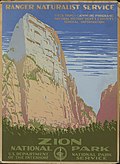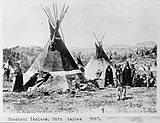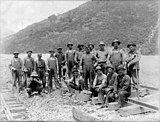Portal:Utah/Selected article
| This page is currently inactive and is retained for historical reference. Either the page is no longer relevant or consensus on its purpose has become unclear. To revive discussion, seek broader input via a forum such as the village pump. |
| Note: Article entries are now being transcluded directly on the main portal page. However, this page should be retained for historical reference. |
Usage
The template used to create these sub-pages is located at {{Selected article}}.
- Add a new Selected article to the next available subpage.
- The list should only contain articles that have been given a quality rating of "B" class, or higher.
- All summaries should have an accompanying free-use image that is relevant to the selected article.
- The summary for all selected articles should be approximately 10 lines, for appropriate formatting in the portal main page.
- Update "max=" to new total for its {{Random portal component}} on the main page.
Selected articles list
Selected article 1
Portal:Utah/Selected article/1
Bryce Canyon National Park is a national park located in southwestern Utah in the United States. Contained within the park is Bryce Canyon. Despite its name, this is not actually a canyon, but rather a giant natural amphitheater created by erosion along the eastern side of the Paunsaugunt Plateau. Bryce is distinctive due to its unique geological structures, called hoodoos, formed from wind, water, and ice erosion of the river and lake-bed sedimentary rocks. The red, orange and white colors of the rocks provide spectacular views.The canyon area was settled by Mormon pioneers in the 1850s and was named after Ebenezer Bryce, who homesteaded in the area in 1875. The area around Bryce Canyon became a United States national monument in 1924 and was designated as a national park in 1928. (Full article...)
Selected article 2
Portal:Utah/Selected article/2 Great Salt Lake, is the largest salt lake in the Western Hemisphere, the fourth largest terminal lake in the world, and the 33rd largest lake on Earth. In an average year the lake covers an area of around 1,700 square miles (4,400 km²), but the lake's size fluctuates substantially due to its shallowness. For instance, in 1963 it reached its lowest recorded level at 950 square miles (1,529 km²), but in 1987 the surface area was at the historic high of 3,300 square miles(5,311 km²).
The lake is the largest remnant of Lake Bonneville, a pluvial lake which covered much of western Utah in prehistoric times. Great Salt Lake is endorheic (has no outlet besides evaporation), and thus has very high salinity, far saltier than sea water. The Jordan, Weber, and Bear rivers (the three major tributaries) deposit around 1.1 million tons of minerals in the lake each year, and the balance of evaporated water is mineral-free, concentrating the lake further. Because of its unusually high salt concentration, most people can easily float in the lake as a result of the higher density of the water, particularly in the saltier north arm of the lake, Gunnison Bay. The lake's shallow, warm waters cause frequent, sometimes heavy lake-effect snows during late fall, early winter, and spring.
Although it has been called "America's Dead Sea", the lake provides habitat for millions of shorebirds and waterfowl, including the largest staging population of Wilson's Phalarope in the world. In addition to native birds and brine shrimp, the lake is also home, oddly enough, to a Chilean flamingo named Pink Floyd. (Full article...)
Selected article 3
Portal:Utah/Selected article/3
The exposed geology of the Bryce Canyon area shows a record of deposition that covers the last part of the Cretaceous Period and the first half of the Cenozoic era in that part of what is now North America. The ancient depositional environment of the region around what is now Bryce Canyon National Park varied from the warm shallow sea in which the Dakota Sandstone and the Tropic Shale were deposited to the cool streams and lakes that contributed to the colorful Claron Formation that dominates the park's amphitheaters.Other formations were also created but were mostly eroded following two major periods of uplift; one around 70 million years ago (creating the Rocky Mountains) and another 10 to 15 million years ago (creating the Colorado Plateaus). The uplift caused vertical joints to form which were much later preferentially eroded to form the free-standing pinnacles, badlands, and monoliths we see today. The formations exposed in the park are part of the Grand Staircase. (Full article...)
Selected article 4
Portal:Utah/Selected article/4
Park City is one of two major resort towns in Utah, the other being Moab. It is considered to be part of the Wasatch Back and a part of the Salt Lake City metropolitan area. The city is 30 miles (48 km) east of downtown Salt Lake City and 15 miles (24km) from Salt Lake City's east edge of Sugar House along Interstate 80. The population was 7,371 at the 2000 census. Its estimated population in 2004 was 7,882. On average, the tourist population greatly outnumbers full-time residents.After a population decline following the shutdown of the area's mining industry the city rebounded during the 1980s and 1990s in the tourism business. The city has three major ski resorts: Park City Mountain Resort, Deer Valley Resort, and The Canyons Resort. The Park City and Deer Valley ski resorts were the major locations for ski and snowboarding events at the 2002 Winter Olympics. Although they receive less snow and have a shorter ski season than do their counterparts in Salt Lake County, such as Snowbird resort, they are much easier to access.
Additionally the city is the main location of the United States's largest independent film festival, the Sundance Film Festival, home of the United States Ski Team, the largest collection of factory outlet stores in northern Utah, the Olympic bobsled course, a luge run, and golf courses. (Full article...)
Selected article 5
Portal:Utah/Selected article/5
Zion National Park is a national park located in the Southwestern United States, near Springdale, Utah. A prominent feature of the 229-square-mile (593 km2) park is Zion Canyon, 15 miles (24 km) long and up to half a mile (800 m) deep, cut through the reddish and tan-colored Navajo Sandstone by the North Fork of the Virgin River. Located at the junction of the Colorado Plateau, Great Basin, and Mojave Desert regions, the park's unique geography and variety of life zones allow for unusual plant and animal diversity. Numerous plant species as well as 289 species of birds, 75 mammals (including 19 species of bat), and 32 reptiles inhabit the park's four life zones: desert, riparian, woodland, and coniferous forest. Common plant species include Cottonwood, Cactus, Datura, Juniper, Pine, Boxelder, Sagebrush, yucca, and various willows. Notable megafauna include mountain lions, mule deer and Golden Eagles, along with reintroduced California Condors and Bighorn Sheep.In 1909, U.S. President William Howard Taft named the area a National Monument to protect the canyon, under the name of Mukuntuweap National Monument. However, in 1918, the acting director of the newly created National Park Service changed the park's name to Zion as the original name was locally unpopular. Zion is an ancient Hebrew word meaning a place of refuge or sanctuary. The United States Congress established the monument as a National Park on November 19, 1919. The Kolob section was proclaimed a separate Zion National Monument in 1937, but was incorporated into the park in 1956. (Full article...)
Selected article 6
Portal:Utah/Selected article/6
Lake Powell is a man-made reservoir on the Colorado River, straddling the border between Utah and Arizona. It was created by the flooding of Glen Canyon by the controversial Glen Canyon Dam, which also led to the creation of Glen Canyon National Recreation Area, a popular summer destination. The reservoir is named for explorer John Wesley Powell, a one-armed American Civil War veteran who explored the river via three wooden boats in 1869. In 1972, Glen Canyon National Recreation Area was established. It is public land managed by the National Park Service, and available to the public for recreational purposes. Lake Powell is arguably one of the most scenic lakes in America, situated in some of Southern Utah's finest red-rock desert country. It is second in size only to Lake Mead downstream. With both lakes storing about 25,000,000 acre-feet (31 km3) of water each when full, the water is a valuable resource for the western U.S.Lake Powell boasts over 1,900 miles (3100 km) of shoreline, more than the entire coast of the western U.S. and has 96 major side canyons. (Full article...)
Selected article 7
Portal:Utah/Selected article/7
The geology of the Zion and Kolob canyons area includes nine known exposed formations, all visible in Zion National Park in the state of Utah in the United States, and representing about 150 million years of mostly Mesozoic-aged sedimentation. Part of the Grand Staircase, the formations exposed in the Zion and Kolob area were deposited in several different environments that range from warm shallow seas, streams, and lakes to large deserts and dry near shore environments. Subsequent uplift of the Colorado Plateau exposed these sediments to erosion by streams that preferentially cut through weaker rocks and jointed formations. Much later, lava flows and cinder cones covered parts of the Zion area.Zion National Park includes an elevated plateau that consists of sedimentary formations that dip very gently to the east. This means that the oldest strata are exposed along the Virgin River in the Zion Canyon part of the park, and the youngest are exposed in the Kolob Canyons section. The plateau is bounded on the east by the Sevier Fault Zone, and on the west by the Hurricane Fault Zone. Weathering and erosion along north-trending faults and fractures influence the pattern of landscape features associated with canyons in this stream-incised plateau region. (Full article...)
Selected article 8
Portal:Utah/Selected article/8
The Bear River Massacre, also called the Battle of Bear River and the Massacre at Boa Ogoi, took place on January 29, 1863, between the United States Army and the Shoshone Indians at the confluence of the Bear River and Beaver Creek (now Battle Creek) near Preston in present day Franklin County, Idaho. The detachment of the U.S. Army was led by Col. Patrick Edward Connor as a part of the Bear River Expedition against Shoshone Chief Bear Hunter.There were several incidents in the summer and fall of 1862 that lead to the eventual confrontation. While viewed as isolated incidents they seem insignificant, when grouped together a picture of broad struggles over almost the entire United States west of the Mississippi River can be seen during this time period when the attention of the nation was focused on the battles going on in the eastern states. Modern historians have often overlooked these incidents because they occurred near the ill-defined boundary of two different territorial jurisdictions (Washington Territory and Utah Territory), where the incidents are geographically close but the administrative centers dealing with them are over 1000 miles apart. Indeed, the vicinity of Franklin and the general location of the conflict was assumed to be in the Utah Territory, with residents of Franklin sending elected representatives to the Utah Territorial Legislature and participating in the politics of Cache County, Utah until 1872 when a surveying team pointed out that they were, in fact, in Idaho. (Full article...)
Selected article 9
Portal:Utah/Selected article/9
The exposed geology of the Capitol Reef area presents a record of mostly Mesozoic-aged sedimentation in an area of North America in and around Capitol Reef National Park. Nearly 10,000 feet (3,000 m) of sedimentary strata are found in the Capitol Reef area, representing nearly 200 million years of geologic history of the south-central part of the U.S. state of Utah. These rocks range in age from Permian (as old as 270 million years old) to Cretaceous (as young as 80 million years old.) Rock layers in the area reveal ancient climates as varied as rivers and swamps (Chinle Formation), Sahara-like deserts (Navajo Sandstone), and shallow ocean (Mancos Shale). (Full article...)Selected article 10
Portal:Utah/Selected article/10
SkyWest Airlines is one of two airlines owned by SkyWest, Inc. - the other being Atlantic Southeast Airlines. It is a North American regional airline headquartered in St. George, Utah, flying to 154 cities in 43 states, Canada, and Mexico. The airline serves as a feeder airline, operating under contract with various major carriers. It flies as United Express on behalf of United Airlines, as Delta Connection on behalf of Delta Air Lines, and as Midwest Connect on behalf of Midwest Airlines.Combined with Atlantic Southeast Airlines, the two make up the eighth-largest airline in terms of number of planes, operating 440 regional aircraft.
The airline employs over 11,100 people and averages 1,794 daily departures across its network. Approximately 65% of flights are operated as United Express, 31% as Delta Connection, and 4% as Midwest Connect. (Full article...)
Selected article 11
Portal:Utah/Selected article/11
The Mormon handcart pioneers were participants in the migration of The Church of Jesus Christ of Latter-day Saints (also known as the Mormon or LDS Church) to Salt Lake City, Utah who used handcarts to transport their belongings. The Mormon handcart movement began in 1856 and lasted until 1860. Motivated to join their fellow Church members but lacking funds for full ox or horse teams, nearly 3,000 Mormon pioneers from England, Wales, and Scandinavia made the journey to Utah in 10 handcart companies. The trek was disastrous for two of the companies after they started their journey dangerously late and were caught by heavy snow and severe temperatures in central Wyoming. Despite a dramatic rescue effort, more than 210 of the 980 pioneers in the two companies died along the way. John Chislett, a survivor of one of these companies, wrote, "Many a father pulled his cart, with his little children on it, until the day preceding his death." (Full article...)Selected article 12
Portal:Utah/Selected article/12
Salt Lake City, Utah is the state capital and most populous city in the U.S. state of Utah. According to 2005 U.S. Census Bureau estimates, the city's population is 178,097. It is the seat of Salt Lake County, which encompasses the Salt Lake Valley and includes the city and fifteen other municipalities. The city's name is often shortened to Salt Lake or referred to by its initials, S.L.C.The Salt Lake City Metropolitan Area spans Salt Lake County and two additional counties, Summit and Tooele, and had a total estimated population of 1,034,484 in 2005. These counties are situated in a greater urban area called the Wasatch Front, home to just over 2 million residents.
Originally named Great Salt Lake City after nearby Great Salt Lake, it was founded in 1847 by a group of Mormon pioneers led by Brigham Young who fled hostility in the East. Salt Lake City is among the oldest cities in the region and is the world headquarters of The Church of Jesus Christ of Latter-day Saints (the LDS or Mormon Church). Mining and railroads initially brought economic growth, and the city became nicknamed the Crossroads of the West. In the 21st century the city has developed a strong tourism industry; it served as host to the 2002 Winter Olympics.
The Salt Lake City Metropolitan Area is the industrial banking center of the United States, the center of business along the rapidly-growing Wasatch Front, and the gateway to several national parks, ski resorts, and resort towns, perhaps most famously Park City. (Full article...)
Selected article 13
Portal:Utah/Selected article/13
The Liberal Party of Utah, along with the People's Party, was a local political party that flourished in Utah Territory in the latter 19th century before Democrats and Republicans established themselves in Utah in the early 1890s.The Liberal Party was formed in 1870 to oppose The Church of Jesus Christ of Latter-day Saints (the LDS Church; popularly known as the "Mormons"), which dominated local politics. Thus, the Liberal Party represented the non-Mormon side in religiously-charged Utah government. Though vastly outnumbered, the Liberal Party offered an opposing voice and successfully won several local elections. Anti-Mormonism was a central theme of the party until it disbanded in 1893 and was absorbed by the national parties. (Full article...)
Selected article 14
Portal:Utah/Selected article/14
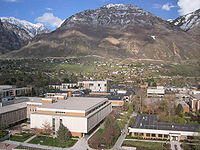
Brigham Young University, often referred to as BYU, is the flagship university of The Church of Jesus Christ of Latter-day Saints (LDS Church). The vast majority of students at BYU are members of this church and, as a condition of admission to the university, they commit to obey a stringent honor code while they attend BYU. BYU is often known for its low tuition costs, especially for a private university of its size. A large number of its students have some proficiency in a foreign language. BYU is located in Provo, Utah, approximately 50 miles to the south of Salt Lake City.
Additional facilities include a study center in Israel (the BYU Jerusalem Center); a satellite campus to the north in Utah's capital and largest city, Salt Lake City, (the BYU Salt Lake Center); and study centers all over the world, including London and Washington, D.C. Until recently, BYU operated an academy for its students at Nauvoo, Illinois, a town that figures prominently in Latter-day Saint history (the Joseph Smith Academy).
Selected article 15
Portal:Utah/Selected article/15

The University of Utah (also The U or the U of U or the UU) is a public university in Salt Lake City, Utah. Originally established February 28, 1850 by Latter-day Saint leader Brigham Young; it was initially named "University of Deseret." The school closed two years later for financial reasons. It reopened as a commercial school in 1867 in the old Council House in what is now downtown Salt Lake City under the direction of David O. Calder, a prominent Salt Lake City businessman and associate of Mormon leader Brigham Young. The University was renamed University of Utah in 1894 and classes were first held on the present campus approximately two miles directly east of downtown Salt Lake City in 1900. It currently enrolls 22,661 undergraduate and 6,531 graduate students and has 3,971 faculty members.
The state-owned University is referred to colloquially as "the U." The university has a ferocious athletic and (some might say) cultural rivalry with its neighbor to the south, Brigham Young University (aka "the Y"), which is owned by The Church of Jesus Christ of Latter-day Saints (commonly known as the LDS Church). The University of Utah is the flagship public research institution in the state of Utah, and is one of 10 institutions that make up the Utah System of Higher Education.
Of more than 3,500 colleges and universities in the United States, the University of Utah is one of only 88 classified by the Carnegie Foundation for the Advancement of Teaching as Research I universities—institutions that offer a full range of undergraduate programs, are committed to graduate education, and give research high priority.
Selected article 16
Portal:Utah/Selected article/16 The Utah Jazz is a professional basketball team based in Salt Lake City, Utah. They play in the National Basketball Association (NBA).
The team was originally the New Orleans Jazz but was financially unsuccessful and moved to Utah. The Jazz were one of the most successful teams in the late 1980s and 1990s, making it to two NBA Finals in 1997 and 1998 under coach Jerry Sloan and anchored by John Stockton and Karl Malone, a point guard/power forward combination noted for its remarkable on-court rapport. Malone and Stockton were often seen as two of the best players at their respective positions.
In 1996-97, the Jazz had their best record in franchise history at 64-18. They reached the NBA Finals for the first time after beating the Los Angeles Clippers 3-0, Los Angeles Lakers 4-1, and Houston Rockets 4-2 to meet Michael Jordan and the Chicago Bulls in the NBA Finals where they lost 4-2. A three-pointer at the buzzer by John Stockton in Game 6 of the 1997 Western Conference Championship sent the Jazz to the finals, and remains one of the iconic moments in team history. In the 1997 NBA Finals, the Jazz lost to the Chicago Bulls 4-2 after fighting the first four games to a 2-2 tie and losing the last two in the last seconds of the game 90-88 and 90-86.
During the 1997-98 season, expectations were high for another championship run. However, John Stockton suffered a serious knee injury before the season began and missed the first 18 games. Despite the setback, the Jazz were still able to finish at 62-20. In the playoffs they beat the Houston Rockets 3-2, the San Antonio Spurs 4-1, and the Los Angeles Lakers 4-0 to advance to their second NBA Finals appearance in a row. In the 1998 NBA Championship, the Jazz took Game 1 at home 88-85. However, the Bulls overcame a slow start to win Game 2 93-88, easily took Game 3 96-54 and won a closer Game 4 86-82 to lead 3-1 in the series. The Jazz fought back to win Game 5 83-81 at the United Center and the series swung back to Salt Lake City. The Jazz held a lead in most of Game 6, but the Bulls rallied, and in the last seconds of the game, Michael Jordan swished a jump shot to win, 87-86.
Selected article 17
Portal:Utah/Selected article/17
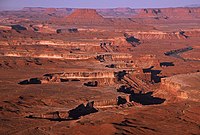
The Green River is a tributary of the Colorado River, 730 miles (1,170 km) long, in the western United States. The Green River Basin covers parts of Wyoming, Utah, and Colorado. The river begins in the Wind River Mountains of Wyoming, and flows through Utah for much of its course, draining the northeastern portion of the state while looping for 40 miles (64 km) into western Colorado. Much of its route is through the Colorado Plateau, some of the most spectacular canyons in the United States. It is the largest tributary of the Colorado.
South of the Flaming Gorge Dam it flows eastward, looping around the eastern tip of the Uinta Mountains going from Utah into northwestern Colorado, then south into Dinosaur National Monument and is joined by the Yampa River at Steamboat Rock. It turns westward back into Utah along the southern edge of the Uintas in Whirlpool Canyon. In Utah it meanders southwest across the Yampa Plateau and through the Uintah and Ouray Indian Reservation and the Ouray National Wildlife Refuge. Two miles south of Ouray, Utah, it is joined by Duchesne River, and three miles downstream by the White River. Ten miles farther downstream it is joined by the Willow River.
South of the plateau, it is joined by the Nine Mile River, then enters the Roan Cliffs where it flows south through the back-to-back Desolation and Gray Canyons, with a combined length of 120 miles (190 km). In Gray Canyon, it is joined by the Price River. South of the canyon it passes the town of Green River, Utah and is joined by the San Rafael River in southern Emery County. In eastern Wayne County it meanders through Canyonlands National Park where it joins the Colorado.
Selected article 18
Portal:Utah/Selected article/18
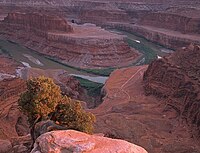
The Colorado River is a river in the southwestern United States and northwestern Mexico, approximately 1,450 mi (2,330 km) long, draining a part of the arid regions on the western slope of the Rocky Mountains. The natural course of the river flows into the Gulf of California, but the heavy use of the river as an irrigation source for the Imperial Valley has desiccated the lower course of the river in Mexico such that it no longer consistently reaches the sea.
The Colorado River's headwaters are located in Rocky Mountain National Park, just west of the Continental Divide. Once inside Utah, the river turns south partially forming the southern border of Arches National Park near Moab, Utah, then passes by Dead Horse Point State Park and through Canyonlands National Park where it is met by one of its primary tributaries the Green River. The river then flows into Lake Powell, formed by the Glen Canyon Dam and into Arizona.
The Colorado River is a major and in some cases life-sustaining source of water for irrigation, drinking, and other uses by people living in the arid American southwest. Allocation of the river's water is governed by the Colorado River Compact. Several dams have been built along the Colorado River, beginning with Glen Canyon Dam near the Utah-Arizona border. Other dams include Hoover Dam, Parker Dam, Davis Dam, Palo Verde Diversion Dam, and Imperial Dam. Since the completion of the dams, the majority of the river in normal hydrologic years is diverted for agricultural and municipal water supply. The Colorado's last drops evaporate in the Sonoran Desert, miles before the river reaches the Gulf of California. Almost 90% of all water diverted from the river is for irrigation purposes. The All-American Canal is the largest irrigation canal in the world and carries a volume of water from 15,000 to 30,000 ft³/s (420 to 850 m³/s), making it larger in volume than New York's Hudson River. The canal's waters are used to irrigate the parched but fertile Imperial Valley, where several years can pass between measurable rainfalls.
Selected article 19
Portal:Utah/Selected article/19

The 2002 Winter Olympics, officially known as the XIX Olympic Winter Games, were held in 2002 in Salt Lake City, Utah, United States. Other candidate cities were: Quebec City, Quebec, Canada; Sion, Valais, Switzerland; and Östersund, Sweden. Salt Lake City was selected as the host city on June 16, 1995 at the 104th IOC Session in Budapest. Olympic venues were scattered around Salt Lake City, as well as in the mountains at Park City, Ogden, Provo, Kearns and West Valley City. Athletes were housed in the Olympic Village at the University of Utah.
The 2002 Salt Lake City games became the most populated area to have ever hosted a Winter Olympics, at the time of the Olympics its metropolitan population was 1,516,227.
These Olympic games were the first since September 11, 2001, which meant a higher level of security than ever before provided for the Games.
Competition highlights included biathlete Ole Einar Bjørndalen, winning gold in all four men's events (10 k, 12.5 k, 20 k, 4 x 7.5 relay), Simon Ammann of Switzerland taking the double in ski jumping, and alpine skier Janica Kostelić winning three golds and a silver (the first Winter Olympic medals ever for an athlete from Croatia).
Selected article 20
Portal:Utah/Selected article/20

The Ute (/juːts/; "yoots") are an ethnical related group of American Indians now living primarily in Utah and Colorado. There are three Ute tribal reservations: (1) Uintah-Ouray in northeastern Utah (3,500 members), (2) Southern Ute (1,500 members) and (3) Ute Mountain (2,000 members) — both in southwestern Colorado. (All numbers are approximate) The name of the state of Utah was derived from the name Ute.
The native Ute language belongs to the Uto-Aztecan (Shoshone) family of languages and is a dialect of Southern Numic. However, most current Utes speak only English. Other American Indian groups with native Shoshonean dialects include the Bannocks, Comanches, Chemehuevi, Goshutes, Paiutes and Shoshones.
Prior to the arrival of white settlers, the Utes occupied significant portions of what are today eastern Utah, western Colorado and parts of New Mexico and Wyoming. The Utes were never a unified group; instead, the Utes consisted of numerous nomadic bands that maintained close associations with other neighboring groups. Some of the larger groups included the Moache, Capote, Uncompahgre, White River, Uintah, Pahvant, Timanogots, San Pitch, Moanumts, Sheberetch and Weeminuche. Unlike many other tribal groups in this region, there is no tradition or evidence of migration to the areas now known as Colorado and Utah — ancestors of the Ute appear to have occupied this area for at least a thousand years.
Selected article 21
Portal:Utah/Selected article/21 The Utah War was a 19th century armed conflict between Mormon settlers in Utah Territory and the United States federal government. From 1857 to 1858, the settlers and the government battled for hegemony over the culture and government of the territory. One famous incident during the ordeal was the Mountain Meadows massacre, which was a massacre of unarmed California-bound settlers from Arkansas (perhaps wrongly seen as in league with the federal government).
The Presidential Election of 1856 was a contest between James Buchanan of the established Democratic party and John C. Frémont of the newly organized Republican party. Buchanan eventually prevailed, but the credibility of the Democratic party had been shaken. The Republicans charged the Democrats with being soft on the "twin relics of barbarism"—polygamy and slavery. To regain credibility for the Democrats, Buchanan needed to address the charge, but was also concerned with maintaining the integrity of the union between the states. The only politically viable option for Buchanan was to take the hard-line on polygamy and depose Brigham Young as governor of the Utah Territory. Buchanan chose to appoint Alfred Cumming as the new governor and ordered the U.S. Army to escort Cumming to the Utah Territory.
Nominations
- Adding articles
- Feel free to add FA-Class Utah articles or GA-Class Utah articles to the above list.
- See also Utah articles by quality
- If you are unsure or do not know how to add an entry, feel free to post a question, suggestion or nomination here below, or at the talk page Portal talk:Utah.




